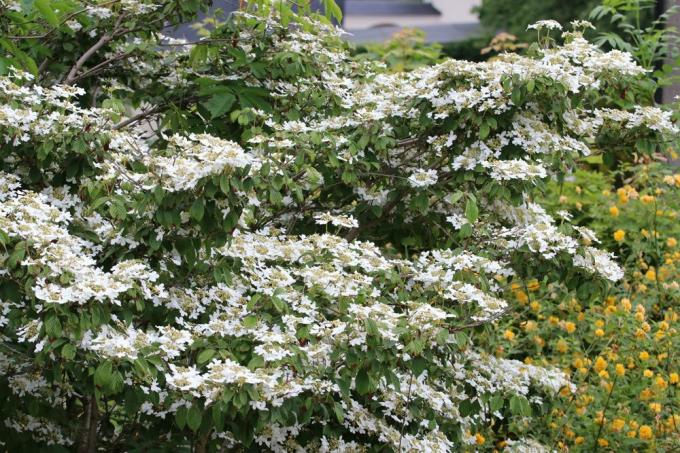
table of contents
- Systematics
- care
- Location
- floor
- to water
- Fertilize
- Cut
- Pests
- sorts
Profile and care information open +conclude -
- Flower color
- White
- Location
- Partial shade, sunny
- Heyday
- May June
- Growth habit
- upright, expansive
- height
- up to 200 centimeters high
- Soil type
- sandy
- Soil moisture
- moderately moist, fresh
- PH value
- weakly acidic
- Limescale tolerance
- Calcium tolerant
- humus
- rich in humus
- Poisonous
- Yes
- Plant families
- Musk herb family, Adoxaceae
- Plant species
- Ornamental shrubs, flowering shrubs
- Garden style
- Ornamental garden, heather garden, natural garden
Its large, creamy white flowers are its special feature. With its stately size of up to three meters, the Japanese snowball 'Mariesii' attracts the eye of the beholder. Like all snowballs from the genus Viburnum, a Japanese snowball 'Mariesii' is one of the most attractive shrubs in the home garden. Even when it is fading it is wonderfully beautiful. Then the flowers take on a light pink tone and its leaves take on a dark red color.
Systematics
- Order: Dipsacales
- Family: musk plants
- Genus: Viburnum

care
A Japanese snowball is one of the approximately 200 species of the genus Viburnum worldwide. Originally only two species of the attractive plants of this genus were native to Central Europe. But the Japanese snowball also finds good conditions in our latitudes. Viburnum plicatum is extremely robust and, with a little care, will thrive to full splendor and size.
The Japanese snowball cannot tolerate long periods of drought. In contrast to the other representatives of the genus Viburnum, the Japanese snowball 'Mariesii' hardly bears any fruit and is not evergreen. It sheds its leaves in the winter months.
Location
The Japanese snowball is considered a relatively undemanding plant in terms of its location. In fact, it thrives almost everywhere. However, if a plant is to develop its full beauty, these are the best conditions.
- sunny and partially shaded locations
- some varieties need a lot of sun
- the light encourages them to develop more flowers
- most plants even accept shade
- however, they clearly lose vitality in these locations
floor
When deciding on the floor, it is worthwhile to consider the special requirements of the Japanese snowball. It needs fresh and moist soil for its thriving development. It can also be slightly angry. Long-term drought is not good for any specimen of the Japanese Snowball. Conversely, the bushes are also damaged by waterlogging.
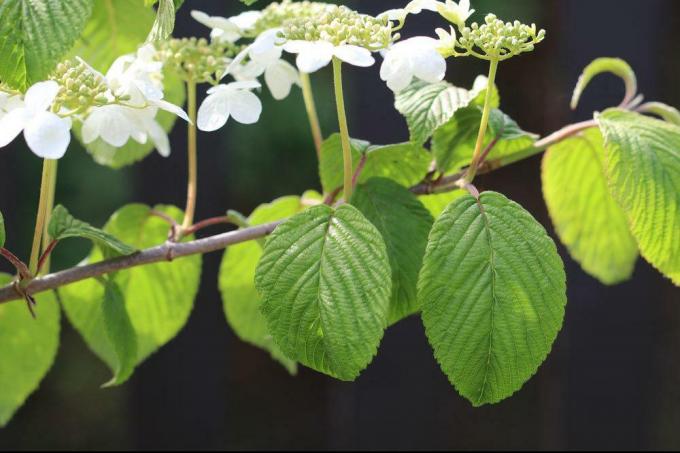
In general, the following applies to the floor:
- nutritious
- profound
- well permeable
- fresh
- at PH value tolerant
Japanese snowballs thrive particularly well in an optimal place. A shrub of this type is ideal in places in the garden where reliable privacy protection is required. Because most shrubs of this type grow very dense and sufficiently high.
Plan enough space when planting
A Japanese snowball grows best outdoors. No special precautions need to be taken when planting a snowball of this type. However, depending on the type and variety, some shrubs of the Japanese snowball can reach considerable proportions. The Japanese snowball Viburnum plicatum 'Mariesii', for example, is up to three meters wide under optimal conditions.
Such a shrub is best planted as a solitary. Even with other varieties of Japanese snowball, the gardener should think about the plants and shrubs in the neighborhood before planting them. If you want to admire Japanese snowballs in your garden, you should plan enough space.
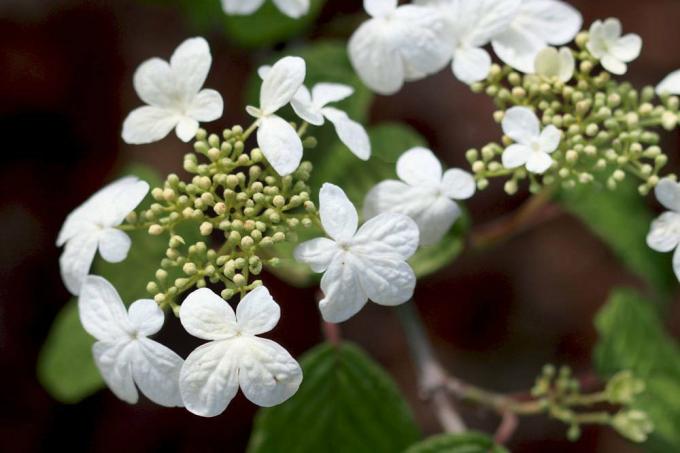
The optimal distance to the next plant is quite different for each variety of Viburnum plicatum. It should be noted that the snowball has to develop root mass underground. Shall be a short version of the snowball, such as the Japanese snowball summer Snowflake, standing in a hedge, he still needs more than half a meter of space to the next Snowball.
to water
If the Japanese snowball comes to stand in full sun, it has to be supplied with water more intensively. Excessive watering is not necessary in partial shade. However, all varieties of the Japanese Snowball need regular watering during the warm and dry months of summer.
- Never let the soil dry out completely
- outer fine roots die quickly in drought
- Beware of extreme heat
- it is better to pour plenty of water once
- Do not pour in more water until the top layer of soil has dried
- Pay attention to the proper drainage of the irrigation water
- Waterlogging damages the snowball
Fertilize
Fertilizer depending on the location
How intensive the supply of nutrients should be depends on the nutrient content of the soil in which the snowball is located.
Guidelines for optimal fertilization:
- Enrich nutrient-poor soil with a complete organic fertilizer during the season
- In damp locations, fertilize snowballs with natural compost, which can be slightly acidic
- Mulch around the roots can replace other nutrients
- Avoid fertilizers with an emphasis on nitrogen
- This fertilizer makes blooming snowballs lazy
- gives soil analysis need to give nitrogen fertilizer in an organic form
- is degraded more slowly
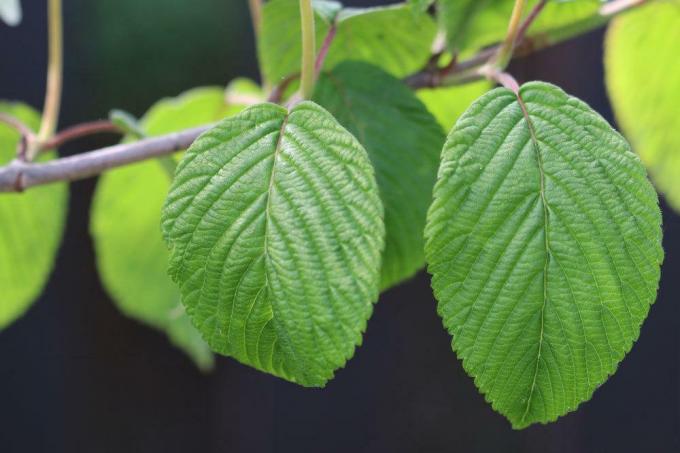
Cut
The Japanese snowball does not need an explicit cut in any of its varieties. If the plants are in a good location as solitary plants, they do not have to be cut at all costs. With enough space around it, the shrub can grow freely. In this case, only broken, diseased and transversely growing branches are cut out of the viburnum plicatum. This can happen at any point in the growth phase.
Is the sand location of Viburnum plicatum chosen so that the snowball is in the development and Development must adapt to the given environment, it can also change its shape through a cut obtain. However, the gardener initially gives the shrub some time to develop after it has been planted. A first cut is only made on a three to four year old shrub.
Instructions for the optimal cut:
- Pruning takes place in late spring
- the time after flowering is optimal
- important: before new shoots appear
- Always cut the oldest wood first
- It is best to start the cut close to the ground
- start for the shaping cut
- shorten shoots that are too long
- remove diseased growth
- leave younger shoots on the bush
- this is where the next flower develops
Once a Japanese snowball is completely out of its shape, it can exceptionally be radically cut back. The plant tolerates this measure without any problems. However, there will be no flowers or very few of them on the bush in the following season. Such a radical cut and the subsequent formation of a new bloom cost the plant a lot of strength. For this reason, Viburnum plicatum should only be radically pruned at an interval of three or more years.
Overwinter
Japanese snowballs are winterproof. They get through the cold months of winter without any particular problems, even in rough locations. The gardener should be a little more careful with young plants. You have to pay attention to them, especially in extreme weather conditions. In winter, they should be covered with a protective sack made of linen or jute for the first few years.
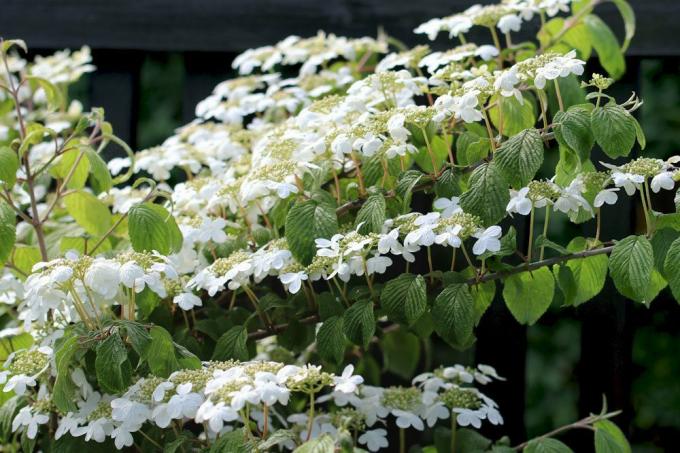
Pests
The snowball is considered to be the winter host for the black aphids. Other aphids also prefer to settle on it, especially when it is growing. Healthy plants, in particular, survive infestation with these pests. The pests usually only need to be combated when they have attacked weak and young plants. A shower with water is usually sufficient.
The snowball leaf beetle is an annoying pest. The larvae mainly attack the leaves. In the worst case scenario, in the worst case scenario they will eat the entire shrub bare. Targeted prevention helps against leaf beetles. If the first signs of an infestation appear in spring, all affected leaves must be removed. Don't put them in the compost. It is safest to destroy the larvae on it. The gardener can also buy rings of glue to prevent infestation by leaf beetles and attach them to the trunk.
Diseases also affect the Japanese snowball. Powdery mildew is one of the common diseases of the Japanese snowball. As a rule, the disease does not cause much damage to the plant.
sorts
Attractive plants for the home garden
The Japanese snowball comes in quite different versions. All trees and shrubs of the genus that can be bought in this country thrive well and, with a little care, develop their magnificent flowers over a period of weeks. They lose their foliage in winter, so they are not evergreen.

Japanese dwarf snowball 'Watanabe' (Viburnum plicatum 'Watanabe')
The Japanese dwarf snowball 'Watanabe' is a rather small shrub. When planted as a trunk, the trunk will grow in thickness over time. The crown is also wider and reaches a diameter of up to 120 centimeters.
- Growth: compact, trunk with crown
- Width: 1.20 to 1.50 meters
- Height: 1.50 to 2 meters
- Growth rate: 10 to 20 centimeters per year
- Flower color: silvery white
- Flower shape: umbels
- Flowering period: July to August
- Leaf: fresh green
- Autumn color: wine red
- Foliage: Deciduous
- Soil: well drained, fresh
- Location: sun to partial shade
- Use: solitaire
- toxic: yes
Japanese snowball 'Summer Snowflake' (Viburnum plicatum 'Summer Snowflake')
This Japanese snowball blooms for a long time. It shows its bright white flowers from May to September. In good years it even blooms until November. With a total height of 80 centimeters, Summer Snowflake is one of the dwarfs among the snowballs. With age, however, some specimens can become significantly larger under good conditions and grow to over two meters.
- Growth: as tall as wide, compact
- Width: 60 to 80 centimeters
- Height: 60 to 100 centimeters
- Flower color: pure white
- Flowering period: May to September
- Leaf: fresh green
- Autumn color: red tones
- Foliage: deciduous
- Soil: normal, nutrient-rich, fresh and moist
- Location: sun to partial shade
- Use: discounts, individual and group positions
Japanese snowball 'Pink Beauty' (Viburnum plicatum 'Pink Beauty')
This variety of the Japanese snowball grows circular and branches horizontally. The shrub blooms white in June and July. Later the flowers appear tinged with pink. After flowering, 'Pink Beauty' bears fruit in a striking red.
- Growth: broad, round, branches horizontally
- Width: 1.50 to 2.00 meters
- Height: 1.50 to 1.80 meters
- Flower color: white pink
- Flowering period: June to July
- Leaf: elliptical
- Leaf color: medium green
- Autumn colors: yes, different shades of red
- Foliage: deciduous
- Soil: fresh, moist, acidic to alkaline
- Location: sun to partial shade
- Use: borders, ornamental shrubs
Japanese snowball 'Lanarth' (Viburnum plicatum 'Lanarth')
This quite broad shrub forms attractive white inflorescences. They appear in panicles. The flowers are followed by red fruits, which turn black after a few weeks.
- Growth: broadly spreading
- Width: 1.50 to 2 meters
- Height: 1.70 to 2 meters
- Flower: white
- Inflorescence: panicles
- Flowering period: May to June
- Foliage color: medium green
- Autumn colors: yes, shades of red
- Soil: fresh to moist, rich in nutrients
- Location: sun to partial shade
- Use: solitaire

